Analyzing the Impacts of Public Policy on COVID-19 Transmission: A Case Study of the Role of Model and Dataset Selection Using Data from Indiana
IF 1.5
Q2 SOCIAL SCIENCES, MATHEMATICAL METHODS
引用次数: 4
Abstract
ABSTRACT Dynamic estimation of the reproduction number of COVID-19 is important for assessing the impact of public health measures on virus transmission. State and local decisions about whether to relax or strengthen mitigation measures are being made in part based on whether the reproduction number, Rt , falls below the self-sustaining value of 1. Employing branching point process models and COVID-19 data from Indiana as a case study, we show that estimates of the current value of Rt , and whether it is above or below 1, depend critically on choices about data selection and model specification and estimation. In particular, we find a range of Rt values from 0.47 to 1.20 as we vary the type of estimator and input dataset. We present methods for model comparison and evaluation and then discuss the policy implications of our findings.公共政策对COVID-19传播的影响分析——以印第安纳州数据为例研究模型和数据集选择的作用
动态估计COVID-19的繁殖数对于评估公共卫生措施对病毒传播的影响具有重要意义。州和地方关于是放松还是加强缓解措施的决定,在一定程度上取决于繁殖数Rt是否低于自我维持值1。以分支点过程模型和来自印第安纳州的COVID-19数据为例,我们发现对Rt当前值的估计,以及它是高于还是低于1,主要取决于对数据选择和模型规范和估计的选择。特别是,当我们改变估计器和输入数据集的类型时,我们发现Rt值的范围从0.47到1.20。我们提出了模型比较和评估的方法,然后讨论了我们的研究结果的政策含义。
本文章由计算机程序翻译,如有差异,请以英文原文为准。
求助全文
约1分钟内获得全文
求助全文
来源期刊

Statistics and Public Policy
SOCIAL SCIENCES, MATHEMATICAL METHODS-
CiteScore
3.20
自引率
6.20%
发文量
13
审稿时长
32 weeks
 求助内容:
求助内容: 应助结果提醒方式:
应助结果提醒方式:


